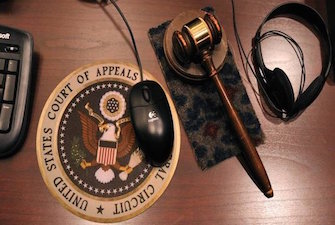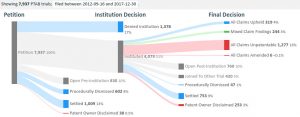 On Wednesday, December 27th, the Court of Appeals for the Federal Circuit entered a non-precedential decision in Nintendo of America, Inc., et. al. v. iLife Technologies, Inc. which affirmed-in-part a final written decision issued by the Patent Trial and Appeal Board (PTAB) which upheld claims of a patent challenged by Japanese video gaming giant Nintendo. While the recent decision did uphold the PTAB’s finding of validity of some claims, the Federal Circuit reversed and remanded part of the decision in a way that further highlights the revolving door of validity challenges taking place between the Federal Circuit and the PTAB. This Federal Circuit decision was made unanimously by a panel including Circuit Judges Alan Lourie, Richard Taranto and Raymond Chen with Chen penning the opinion.
On Wednesday, December 27th, the Court of Appeals for the Federal Circuit entered a non-precedential decision in Nintendo of America, Inc., et. al. v. iLife Technologies, Inc. which affirmed-in-part a final written decision issued by the Patent Trial and Appeal Board (PTAB) which upheld claims of a patent challenged by Japanese video gaming giant Nintendo. While the recent decision did uphold the PTAB’s finding of validity of some claims, the Federal Circuit reversed and remanded part of the decision in a way that further highlights the revolving door of validity challenges taking place between the Federal Circuit and the PTAB. This Federal Circuit decision was made unanimously by a panel including Circuit Judges Alan Lourie, Richard Taranto and Raymond Chen with Chen penning the opinion.
The patent at issue in this case is U.S. Patent No. 6864796, entitled Systems Within a Communication Device for Evaluating Movement of a Body and Methods of Operating the Same. Issued to Dallas, TX-based iLife in March 2005, it claims a system involving a sensor which sense dynamic and static accelerative phenomena of a body and a processor determining if an evaluated body movement is within an environmental tolerance to generate a tolerance indicia. This August, a jury verdict entered in the Northern District of Texas awarded $10.1 million in a lump sum royalty to iLife after the medical tech firm alleged that motion-controlled video gaming elements of Nintendo’s Wii U console infringed upon the ‘796 patent.
The road leading towards the $10.1 million verdict issued this August has been fraught with difficulties for iLife. The ‘796 patent is one of six originally asserted by iLife against Nintendo; the other five were invalidated through inter partes review (IPR) proceedings petitioned by Nintendo. U.S. Patent No. 7479890, titled System and Method for Analyzing a Body, had claims invalidated in a final written decision issued by the PTAB in April 2015 under 35 U.S.C. § 103 statutory grounds for obviousness. Nintendo’s obviousness claims relied on two pieces of prior art: a Japanese patent application published in November 1998 covering a portable accident monitoring device capable of accurate analysis of acceleration data; and a European patent application filed in February 1997 covering a method, apparatus and system for automatically recognizing motions and actions of moving objects such as humans. iLife’s U.S. Patent No. 7095331, titled System and Method for Detecting Motion of a Body, had claims invalidated in a final written decision issued in April 2016 by the PTAB on obviousness grounds over the same two pieces of prior art.
On the same day that the PTAB invalidated claims of the ‘331 patent, it issued a final written decision on the ‘796 patent which found that Nintendo did not prove invalidity of the challenged claims by a preponderance of the evidence. Nintendo had challenged the ‘796 patent on obviousness grounds in light of the same Japanese patent application, referred to as “Yasushi,” it had submitted as prior art in the other IPR proceedings. The PTAB found against Nintendo’s obviousness arguments that Yasushi was prior art because iLife had submitted declarations from inventors and witnesses that the inventors had reduced the invention to practice by August 1998, two months prior to the publication of the Yasushi patent application. An inventor’s declaration submitted by iLife to the IPR proceedings on the ‘796 patent discusses field testing of multiple software versions of the invention on a working prototype of a fall detection device and base station.
The recent Federal Circuit decision on Nintendo’s appeal of the ‘796 final written decision issued by the PTAB found that substantial evidence supports the PTAB’s determination that the challenged claims of the ‘796 patent were adequately supported by the written description of the grandparent application. However, the Federal Circuit reversed and remanded because the panel did not believe all of the challenged claims were reduced to practice as the result of the 1998 working prototype. The existence of a reduction to practice associated with the 1998 working prototype is important because if all of the claims has been reduced to practice with the 1998 working prototype Yasushi would not be prior art.
In the discussion regarding the time at which the invention covered by the ‘796 patent were reduced to practice, the Federal Circuit agreed with the PTAB that substantial evidence supported that exemplary claim 1, similar claim 10 and then dependent claims 2 and 11 were reduced to practice by August 1998. However, the Federal Circuit panel disagreed that substantial evidence supported that dependent claims 3 and 12 were reduced to practice during that time frame; the panel found no evidence that the working prototype included a handheld computer, a laptop computer or a wireless Internet access device. The Federal Circuit panel came to a similar finding on dependent claims 19 and 20 of the ‘796 patent; claim 19 is directed to the generation of state indicia in response to sensed accelerative data and claim 20 is directed to the generation of an output signal indicative of measurements of static and dynamic acceleration in a body. The PTAB panel had relied on inventor testimony that the prototype “communicated information indicating whether the evaluated body was within tolerance” to determine that claims 19 and 20 were reduced to practice in the August 1998 prototype. The Federal Circuit, however, found that this statement only related to the transmission of tolerance indicia, not state or dynamic indicia, and thus the PTAB’s conclusion lacked substantial evidence.
 Last summer, research of PTAB trials using legal data analytics showed that perhaps more than 90 percent of patents challenged through validity trials at the PTAB were being rendered defective. As of December 31st, only 319 petitions for patent validity challenges at the PTAB, or 4 percent of the total 7,937 petitions filed at the PTAB, have led to final written decisions where all claims of a challenged patent are upheld as valid. Through the latter half of 2017, news continued to emerge regarding the Federal Circuit’s ability to double down on PTAB proceedings and dismantle the few patents that do survive PTAB validity trials. In July, the Federal Circuit reversed and remanded parts of a PTAB final decision which had upheld certain patent claims owned by Intellectual Ventures which covered a technology for superimposing a keyboard image on a touchscreen. A few weeks later, the Federal Circuit struck down a patent owned by Whirlpool which covered a blender having crushed ice functionality after that patent also survived IPR proceedings at the PTAB. The remanding of the PTAB’s final written decision on the validity of the iLife patent comes after the jury verdict entered in the Northern Texas case against Nintendo did not find in favor of Nintendo’s arguments that the ‘796 patent was invalid for lack of adequate written description or lack of enablement.
Last summer, research of PTAB trials using legal data analytics showed that perhaps more than 90 percent of patents challenged through validity trials at the PTAB were being rendered defective. As of December 31st, only 319 petitions for patent validity challenges at the PTAB, or 4 percent of the total 7,937 petitions filed at the PTAB, have led to final written decisions where all claims of a challenged patent are upheld as valid. Through the latter half of 2017, news continued to emerge regarding the Federal Circuit’s ability to double down on PTAB proceedings and dismantle the few patents that do survive PTAB validity trials. In July, the Federal Circuit reversed and remanded parts of a PTAB final decision which had upheld certain patent claims owned by Intellectual Ventures which covered a technology for superimposing a keyboard image on a touchscreen. A few weeks later, the Federal Circuit struck down a patent owned by Whirlpool which covered a blender having crushed ice functionality after that patent also survived IPR proceedings at the PTAB. The remanding of the PTAB’s final written decision on the validity of the iLife patent comes after the jury verdict entered in the Northern Texas case against Nintendo did not find in favor of Nintendo’s arguments that the ‘796 patent was invalid for lack of adequate written description or lack of enablement.

![[IPWatchdog Logo]](https://ipwatchdog.com/wp-content/themes/IPWatchdog%20-%202023/assets/images/temp/logo-small@2x.png)

![[Advertisement]](https://ipwatchdog.com/wp-content/uploads/2024/04/Patent-Litigation-Masters-2024-sidebar-early-bird-ends-Apr-21-last-chance-700x500-1.jpg)

![[Advertisement]](https://ipwatchdog.com/wp-content/uploads/2021/12/WEBINAR-336-x-280-px.png)
![[Advertisement]](https://ipwatchdog.com/wp-content/uploads/2021/12/2021-Patent-Practice-on-Demand-recorded-Feb-2021-336-x-280.jpg)
![[Advertisement]](https://ipwatchdog.com/wp-content/uploads/2021/12/Ad-4-The-Invent-Patent-System™.png)







Join the Discussion
No comments yet.